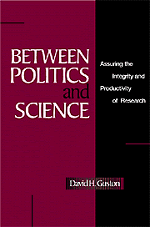Book contents
- Frontmatter
- Contents
- Tables and Figures
- Abbreviations
- Preface
- Introduction: Making Space for Science Policy
- Chapter 1 Science Policy: Structure and Boundaries
- Chapter 2 Understanding the Social Contract for Science
- Chapter 3 Challenges to the Social Contract for Science
- Chapter 4 Assuring the Integrity of Research
- Chapter 5 Assuring the Productivity of Research
- Chapter 6 Between Politics and Science
- Notes
- References
- Index
Introduction: Making Space for Science Policy
Published online by Cambridge University Press: 14 October 2009
- Frontmatter
- Contents
- Tables and Figures
- Abbreviations
- Preface
- Introduction: Making Space for Science Policy
- Chapter 1 Science Policy: Structure and Boundaries
- Chapter 2 Understanding the Social Contract for Science
- Chapter 3 Challenges to the Social Contract for Science
- Chapter 4 Assuring the Integrity of Research
- Chapter 5 Assuring the Productivity of Research
- Chapter 6 Between Politics and Science
- Notes
- References
- Index
Summary
It is not that science did not deliver in so many ways over so many years, but rather that different times require different types of accountability.
– Neal Lane, then director of the National Science Foundation (1997: 127).In his important but now rarely read book, The Scientific Estate, political scientist Don K. Price (1965) devised an intellectual framework that sought to accommodate a free yet accountable science and a pluralistic and representative democracy. To resolve this thoroughly modern problem, Price found premodern inspiration. He drew on the medieval system of estates to organize what he called the “spectrum from truth to power.”
Four estates comprise Price's spectrum, and each is distinct in its pursuit of a defining function. The political estate pursues action and power, constrained by the forms of democratic governance. The scientific estate pursues knowledge and truth, constrained by the norms of scientific work. Between politics and science lie the administrative and professional estates, respectively. The administrative estate applies general or interdisciplinary knowledge according to public rules and laws, under the close oversight of the political estate. The professional estate applies specific or disciplinary knowledge according to private codes and norms, guided by the scientific estate.
One of Price's contributions in the formulation of the spectrum from truth to power is his interposing of the domains of administration and the professions between politics and science.
- Type
- Chapter
- Information
- Between Politics and ScienceAssuring the Integrity and Productivity of Reseach, pp. 1 - 13Publisher: Cambridge University PressPrint publication year: 2000

